Natural Gas Distribution
Distribution is the final step in delivering natural gas to customers. While some large industrial, commercial, and electric generation customers receive natural gas directly from high capacity interstate and intrastate pipelines (usually contracted through natural gas marketing companies), most other users receive natural gas from their local gas utility, also called a local distribution company (LDC). LDCs are regulated utilities involved in the delivery of natural gas to consumers within a specific geographic area. There are two basic types of natural gas utilities: those owned by investors, and public gas systems owned by local governments.
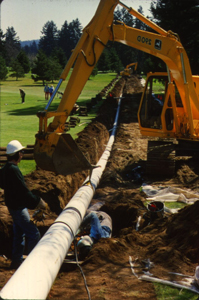 |
| Installing Small Diameter Distribution Pipe |
| Source: Duke Energy Gas Transmission Canada |
Local distribution companies typically transport natural gas from delivery points located on interstate and intrastate pipelines to households and businesses through thousands of miles of small-diameter distribution pipe. The delivery point where the natural gas is transferred from a transmission pipeline to the local gas utility is often termed the ‘citygate’, and is an important market center for the pricing of natural gas in large urban areas. Typically, Utilities take ownership of the natural gas at the citygate, and deliver it to each individual customer’s meter. This requires an extensive network of small-diameter distribution pipe. The U.S. Department of Transportation’s Pipeline and Hazardous Materials Safety Administration reports that there are just over 2 million miles of distribution pipe in the U.S., including city mains and service pipelines that connect each meter to the main.
Because of the transportation infrastructure required to move natural gas to many diverse customers across a reasonably wide geographic area, distribution costs typically make up about half of natural gas costs for households and small volume customers. While large pipelines can reduce unit costs by transmitting large volumes of natural gas, distribution companies must deliver relatively small volumes to many more different locations. According to the Energy Information Administration (EIA), transmission and distribution costs represented about half of a typical residential natural gas customer’s monthly gas utility bill in 2009, with costs of the physical natural gas commodity itself representing the other half.
Delivery of Natural Gas
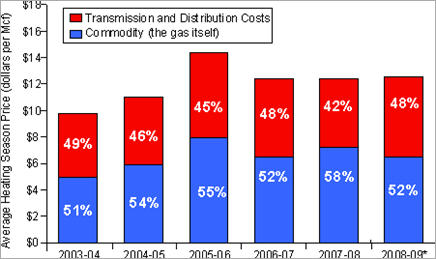 |
| Components of Residential Natural Gas Prices |
| Source: Energy Information Administration-2008 |
The delivery of natural gas to its point of end use by a distribution utility is much like the transportation of natural gas discussed in the transportation section. However, distribution involves moving smaller volumes of gas at much lower pressures over shorter distances to a great number of individual users. Smaller-diameter pipe also is used to transport natural gas from the citygate to individual consumers.
The natural gas is periodically compressed to ensure pipeline flow, although local compressor stations are typically smaller than those used for interstate transportation. Because of the smaller volumes of natural gas to be moved, as well as the small-diameter pipe that is used, the pressure required to move natural gas through the distribution network is much lower than that found in the transmission pipelines. While natural gas traveling through interstate pipelines may be compressed to as much as 1,500 pounds per square inch (psi), natural gas traveling through the distribution network requires as little as 3 psi of pressurization and is as low as ¼ psi at the customer’s meter. The natural gas to be distributed is typically depressurized at or near the citygate, as well as scrubbed and filtered (even though it has already been processed prior to distribution through interstate pipelines) to ensure low moisture and particulate content. In addition, mercaptan – the source of the familiar rotten egg smell in natural gas – is added by the utility prior to distribution. This is added because natural gas is odorless and colorless, and the familiar odor of mercaptan makes the detection of leaks much easier.
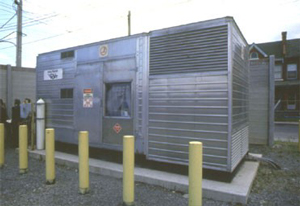 |
| Distribution Compressor Station |
| Source: Duke Energy Gas Transmission Canada |
Traditionally, rigid steel pipe was used to construct distribution networks. However, new technology is allowing the use of flexible plastic and corrugated stainless steel tubing in place of rigid steel pipe. These new types of tubing allow cost reduction, installation flexibility and easier repairs for both local distribution companies and natural gas consumers.
Another innovation in the distribution of natural gas is the use of electronic meter-reading systems. The natural gas that is consumed by any one customer is measured by on-site meters, which essentially keep track of the volume of natural gas consumed at that location. Traditionally, in order to bill customers correctly, meter-reading personnel had to be dispatched to record these volumes. However, new electronic meter-reading systems are capable of transmitting this information directly to the utility. This results in cost savings for the utility, which are in turn passed along to customers.
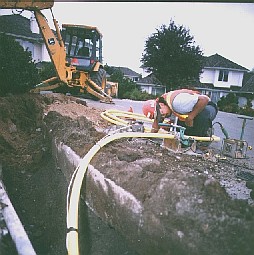 |
| Installing Residential Distribution |
| Source: Duke Energy Gas Transmission Canada |
The installation of natural gas distribution pipe requires the same process as for larger pipelines: the excavation of trenches into which the pipe is laid. However, new trenching techniques are allowing for the installation of distribution pipe with less impact on the above ground surroundings. Guided drilling systems are used to excavate an underground hole in which the pipe may be inserted, and can lead to significant excavation and restoration savings. This is particularly important in crowded urban settings and scenic rural environments, where the installation of natural gas distribution pipe can be a major inconvenience for residents and business owners.
Supervisory control and data acquisition (SCADA) systems, similar to those used by large pipeline companies, are also used by local distribution companies. These systems can integrate gas flow control and measurement with other accounting, billing, and contract systems to provide a comprehensive measurement and control system for the local gas utility. This allows accurate, timely information on the status of the distribution network to be used by the utility, to ensure efficient and effective service at all times.
Regulation of Natural Gas Distribution
Traditionally, local gas utilities have been awarded exclusive rights to distribute natural gas in a specified geographic area, as well as perform services like billing, safety inspection, and providing natural gas hookups for new customers. Like interstate pipelines, utilities have historically been viewed as natural monopolies. Because of the high cost of constructing the distribution infrastructure, it is uneconomic to lay multiple redundant distribution networks in any one area, resulting in only one utility offering distribution services. Because of their position as natural monopolies in a given geographic area, distribution companies have historically been regulated to ensure that monopoly power is not abused, and natural gas consumers do not fall victim to overly high distribution costs or inefficient delivery systems.
State public utility commissions are charged with the oversight and regulation of investor owned local natural gas utilities. Those utilities owned by local governments are typically governed by local government agencies to ensure that the needs and preferences of customers are met in a cost effective manner. State regulation of local distribution companies has a variety of objectives, including ensuring adequate supply, dependable service, and reasonable prices for consumers, while also allowing for an adequate rate of return for investor owned Utilities. State regulators are also responsible for overseeing the construction of new distribution networks, including approving installation sites and proposed additions to the network. Regulatory orders and methods of oversight vary from state to state. To learn more about the regulation of natural gas distribution in your state, click here to visit the National Association of Regulatory Utility Commissioners (NARUC).
Historically, local distribution companies offered only “bundled” services; that is, they combined the cost of transportation, distribution, and the natural gas itself into one price for consumers. However, beginning in the 1990s, residential “customer choice” programs began to be offered as part of a movement toward the retail “unbundling” of natural gas sales. Many states now offer programs in which customers may choose a supplier from whom to purchase the natural gas commodity separately, and use the gas utility simply for service and delivery of that gas. Customer choice programs are in place in more than 20 states and the District of Columbia. To learn more about the status of state distribution customer choice programs, visit EIA.
Although the majority of residential and small commercial customers still tend to purchase ‘bundled’ natural gas from utilities, the increasingly important role of natural gas marketers, as well as the innovation fueled by increasing competition in the marketplace, is leading to innovative ways of supplying natural gas to small volume users as well as new bundled service options, such as home security systems. Please visit our section to learn more about natural gas marketing in residential markets.
Distribution and Safety
Local distribution companies, like the larger interstate and intrastate pipelines, maintain the highest safety standards to ensure that preventable accidents are avoided, and problems with the distribution network are remedied in a timely fashion. Many of the safety programs maintained by utilities are quite similar to those of interstate pipeline companies. Safety measures at the local level include:
- Leak Detection Equipment – Utilities have in place sophisticated leak detection equipment, designed to pick up on leaks of natural gas from the distribution network. Utilities also add odorants to the natural gas to make it easier to detect a leak.
- Safety Education Programs – Utilities typically run natural gas safety seminars in schools, community centers, and through other organizations to ensure customers are well versed in natural gas safety procedures and know what to do in the event of a leak or emergency.
- Technicians on Call – Utilities maintain fleets of technicians on call 24 hours a day, seven days a week to respond to customers’ problems and concerns.
- Emergency Preparedness – Utilities participate in community and local emergency preparedness programs, educating and preparing for emergency events such as natural disasters.
- One Call Systems – Provides customers, contractors, and excavators with a single phone number to call before commencing excavation or construction, to ensure that the pipelines, and other buried facilities are not damaged. A national “call-before-you-dig” phone number of “811” was adopted in 2008 with the support of utilities, communities, emergency responders and government officials.
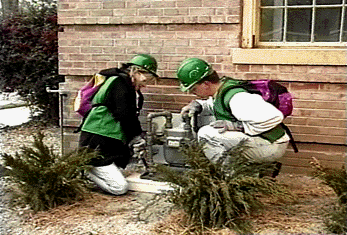 |
| Community Emergency Response Team – Checking Gas Meters |
| Source: Federal Emergency Management Agency |
These are but a few of the safety measures maintained by local distribution companies. Especially important for the safe distribution of natural gas, particularly in densely populated areas, is the education of customers. By teaching natural gas users the safe use of natural gas, what to do in an emergency, and how to detect leaks, distribution companies ensure that the distribution of natural gas will remain one of the safest forms of energy transmission. For more information on natural gas safety in your area, contact your natural gas utility. For information on natural gas pipelines including please visit the Department of Transportation’s Office of Pipeline Safety .